Hand-Coding an API vs. Auto Generating an API | A Comparison
by Jeremy H • October 28, 2024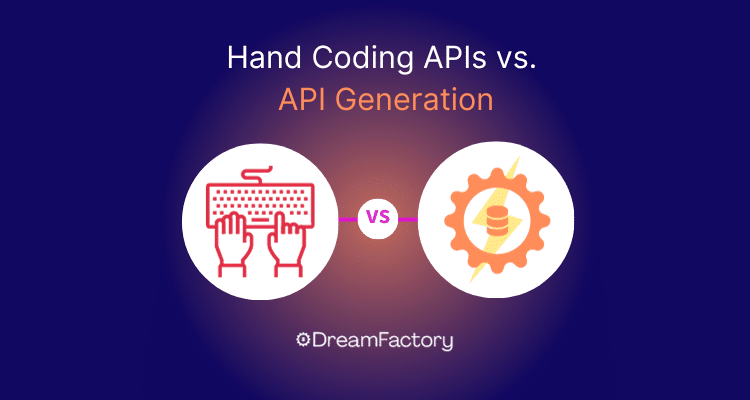
Are you thinking about hand-coding an API? You have the perfect application in mind. It has an attractive UI and achieves everything the customer wants. However, it needs to connect with a Microsoft SQL Server database, so you have to start working on the data model and API. Hand coding APIs offers greater customization and control but is time-intensive, whereas API generation provides a faster, more streamlined approach with automated tools, albeit with less flexibility.
Will you spend a month hand-coding your SQL Server API the hard way? Or will you choose an affordable solution that auto-generates the API in minutes?
Here's the key things to know about Hand-coding an API vs. Auto-generating an API:
- Comparison of Hand-Coding vs. DreamFactory: The summary outlines a comparison between the manual development of a SQL Server API and using DreamFactory's automated approach.
- Cost and Timing Analysis: It highlights a cost and timing analysis for each method, providing insights into labor costs and development timelines.
- Hand-Coding Steps: The manual process of creating a SQL Server API is broken down into steps, including research, database design, prototyping, security measures, and more.
- Cost of Hand-Coding: The article discusses the costs associated with hand-coding, considering both in-house development and outsourcing.
- DreamFactory's Automated Solution: It introduces DreamFactory as a tool that can automatically generate SQL Server APIs, significantly reducing development time and costs.
In this article, we’ll look at the steps, timing, and cost of hand-coding a bespoke SQL Server API. Then we’ll show you how to automatically generate a SQL Server API in minutes with DreamFactory. Believe it or not, DreamFactory can automatically cook up a fully-documented REST API faster than you can prep a bowl of ramen noodles.
Side-by-Side Developer Cost Comparison: Hand-Coded API vs. DreamFactory
Based on our experience hand-coding APIs – and using the DreamFactory API gateway to auto-generate APIs – we’ve summarized labor cost and timing estimates for both solutions in the table below. For a more specific estimate based on your unique project details, try our API cost calculator.
| No. | API Building Step | Hand-Coding Time | Hand-Coding Cost($100/hr In-House) | DreamFactory Time | DreamFactory Cost ($100/hr In-House) |
| 1 | Research | 5 Days | $4,000 | n/a | $0 |
| 2 | Prototype the API | 5 Days | $4,000 | n/a | $0 |
| 3 | Complete the MVP | 6 Days | $4,800 | 5 Minutes | $8.33 |
| 4 | Add API Keys and RBAC | 1 Day | $800 | 3 minutes | $5 |
| 5 | Create Interactive Documentation | 2 Day | $1,600 | Automatic | $0 |
| 6 | Configure API Rate Limiting and Other Restrictions | 1 Days | $800 | 3 minutes | $5 |
| 7 | Configure API Monitoring and Logging | 2 Day | $1,600 | 1 hour | $100 |
| 8 | Configure Alerting | 3 Day | $2,400 | n/a | $0 |
| TOTAL | 25 Days | $20,000* | 1 hr 11 minutes | $118.30 |
*Outsourcing development of a bespoke REST API can cost from $25,000 to $35,000 per API.
Steps for Hand-Coding a Custom SQL Server REST API: The Hard Way
Hand-coding an API is more involved than simply developing an interface for your database. In this section, we’ll look at the steps developers take when creating a bespoke REST API for SQL Server. This process takes approximately 30 days in total. The total project (and each step below) could take more or less time than our estimates depending on complexity.
1. REST API: Research (5 Days)
The first step is research. Gather specific information about the project. What databases or data sources will the API expose? Does the API need to integrate with third-party services? What else do you need to know for the API? Reserve five (5) days for researching the API.
2. Design the Database: Optional (12 Days)
If the SQL Server database doesn’t already exist, you’ll need to design the database schema and upload data. Complex databases could take two weeks or longer to build. Simpler databases take one or days. Consider reserving at least two working weeks (10 - 12 days) for designing a relatively complex database.
3. Prototype the API (5 Days)
Develop your first draft of the API. This will serve as a basic prototype for testing. The results of testing will provide valuable information for refinements and adjustments. Reserve five (5) days for prototyping your SQL Server API.
4. Complete the MVP (6 Days)
From the API prototype, finalize a minimum viable product (MVP) for alpha testing. At this stage, the API should have its essential functions in place. Reserve six (6) days for completing the MVP.
5. Add API Keys and RBAC (1 Day)
Here you will secure access to the API and prevent the chance of a data breach. Generally, modern API security includes API keys and role-based access control (RBAC) at a minimum. Reserve one (1) day for adding API keys and RPAC to the API.
6. Create Interactive Documentation (2 Days)
We recommend documenting your API with Swagger for interactive documentation that syncs with your API inputs, outputs, and endpoint descriptions. Interactive documentation is especially valuable because developers can refer to it while building apps that consume the API. Reserve two (2) days for creating your interactive documentation.
Here’s a screenshot of the Swagger UI. Note the interactive documentation on the right:
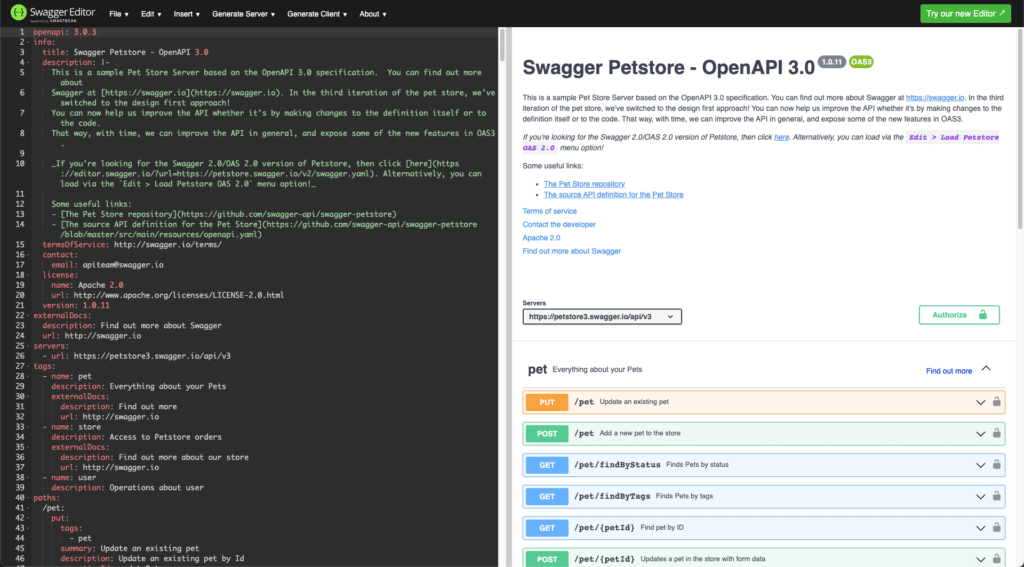
(Source)
7. Configure API Rate Limiting and Other Restrictions (1 Day)
Restricting API interactions with rate limiting and other strategies saves on data access costs, prevents hackers from attacking the system, and circumvents malicious bot activity. Reserve one (1) day for configuring API rate limiting and other API restrictions.
8. Configure API Logging (2 Days)
Meeting your industry’s data compliance standards – like GDPR, CCPA, etc. – generally requires an API traffic logging strategy so industry regulators can audit API activity. Reserve two (2) days for setting up API logging.
9. Configure API Monitoring and Alerting (3 Days)
Setting up real-time monitoring is vital to ensure optimum performance and reliability. You’ll want to configure an API monitoring dashboard that displays:
- HTTP response status codes
- User-specific actions
- API usage and adoption statistics
- Other stats that are important to the project
You’ll also want to configure alerts that notify you when problems arise. Reserve three (3) days for setting up monitoring and alerting.
The Cost of Hand-Coding a SQL Server API
An in-house API developer earning $40/hour will cost approximately $6,400 for the month of labor required to build a custom SQL Server API. Outsourcing the job to a contractor costs more – anywhere from $15,000 to $25,000 for the average REST API.
Costs will vary based on the complexity of your API, as this developer cleverly notes on Quora:

(Source)
If you have a clear picture of your API project – and you want to know more precisely how much time and money it will cost to hand-code your API – try out our API development calculator.
When calculating expenses, remember that API development involves significant costs beyond labor. For example, adding a 30-day task to your development timeline represents a massive time-to-market delay. This interferes with business agility as it slows down your ability to respond to changing conditions. It also interferes with the number of projects your team can finalize each year, which slows down growth and debilitates your bottom line.
Software development companies that continue to hand-code APIs are currently competing against developers using automatic API generation tools (like DreamFactory). These tools completely eliminate the task of manual API development, so developers can offer dramatically lower prices and faster time to market. If your team continues to hand-code APIs the traditional way, you’re literally being left in the dust.
Steps to Automatically Generate APIs with DreamFactory: The Easy Way
DreamFactory is an API Gateway that includes a stunning administrator panel for building and connecting modern microservices-based infrastructures. Most importantly, DreamFactory can automatically generate REST APIs with full Swagger documentation from any database.
Just feed your Microsoft SQL Server database credentials into DreamFactory and the platform instantly generates the API you need. This eliminates weeks of developer hours and tens of thousands of dollars in labor costs from your API development workflow. In most cases, you can generate a fully-documented REST API secured by API keys in less than 15 minutes.
Here’s what one user says about DreamFactory’s automatic REST API generation feature:
"DreamFactory REST API in seconds? Yeah, that's true!! Live documentation of REST API's is a pain for developers. DreamFactory solved this using Swagger-UI. This is the most interesting and lovable thing done by DreamFactory.” -Nagarjuna Y.
Here are the steps required to generate a SQL Server API with DreamFactory:
1. Install DreamFactory (5 Minutes)
DreamFactory includes pre-built connectors for the most popular databases – such as Microsoft SQL Server – and a drag-and-drop administrator dashboard. All you need is a local computer or hosted environment to install DreamFactory, and you’re ready to go.
Click here for a free, 14-day hosted trial of DreamFactory (no credit card required). We’ll set you up with a hosted environment to run DreamFactory, send you a link and password, and you’ll be spitting out SQL Server APIs faster than you can brew a cup of coffee.
2. Generate Your Microsoft SQL Server API (2 Minutes)
After logging into your DreamFactory instance, you’ll find the administrator dashboard. Next, find the Services tab. Select SQL Server from the dropdown, fill out the fields, and connect to the database.
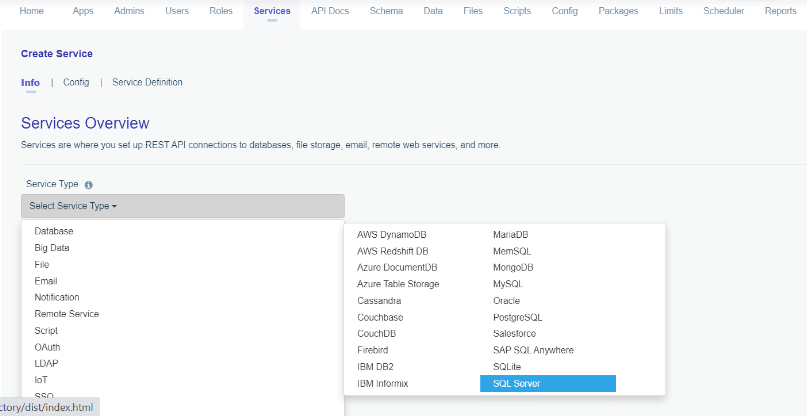
Save your entries. Look for the pop-up that says “Service Saved Successfully,” and you’re done! As simple as that, you have a fully-documented SQL Server Rest API. Click the API Docs tab to find the Swagger documentation. Click the “Try It Out” button to test the API immediately.

Users rave about the speed and convenience of DreamFactory’s automatic REST API generation feature:
“APIs are built for you – and not just any APIs. Fully documented, fully secured (OAuth, LDAP, Active Directory, SAML Integration...) and accessible through a 3rd party client.” -Steve W.
“Fastest and easiest API Management tool my department has ever used. We used DreamFactory to build the REST APIs we needed for a series of projects and were able to save tens of thousands on the developer hours it would have taken otherwise.” -Mark A.
“We are a logistics company that leverages technology to stay ahead of the competition. We used to develop applications from scratch and it used to take a lot of time. But after using DreamFactory the work became extremely simple and APIs could be developed in just almost no time. It helped us move ahead especially with online forms filing work and saved a lot of fines for the organization.” -Astha S.
3. Secure the API with API Keys and RBAC (3 Minutes)
Next, we’ll secure the API with an API Key and Role-Based Access Control (RBAC). Click the Roles tab and select “Create” to set up a Role for the API. Under the Service column, point the Role to your newly-made SQL Server Service. Under the access column, limit access to GET calls. This allows the Role to read the database but not make any changes. Save the Role and you’re ready to create the API Key.
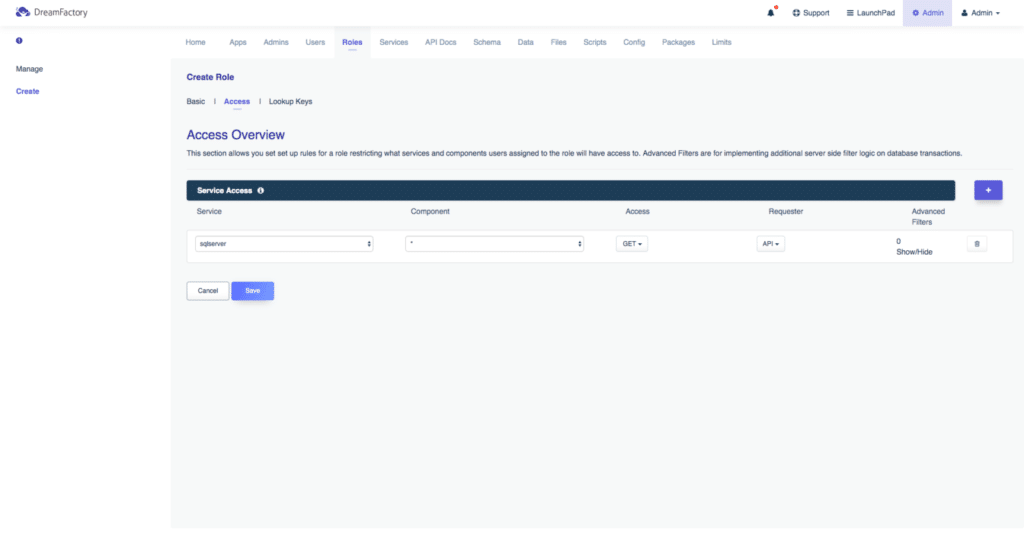
Click the Apps tab and select “Create” to generate an API Key. Complete the fields, assign the Key to the Role, save, and the API Key is ready!
4. Try Out the API
To demonstrate the API in action, we’ll use an HTTP service, Insomnia, to call the DreamFactory API. In the example below, we called the customers table. Notice how the API key is identified in the headers for authentication.
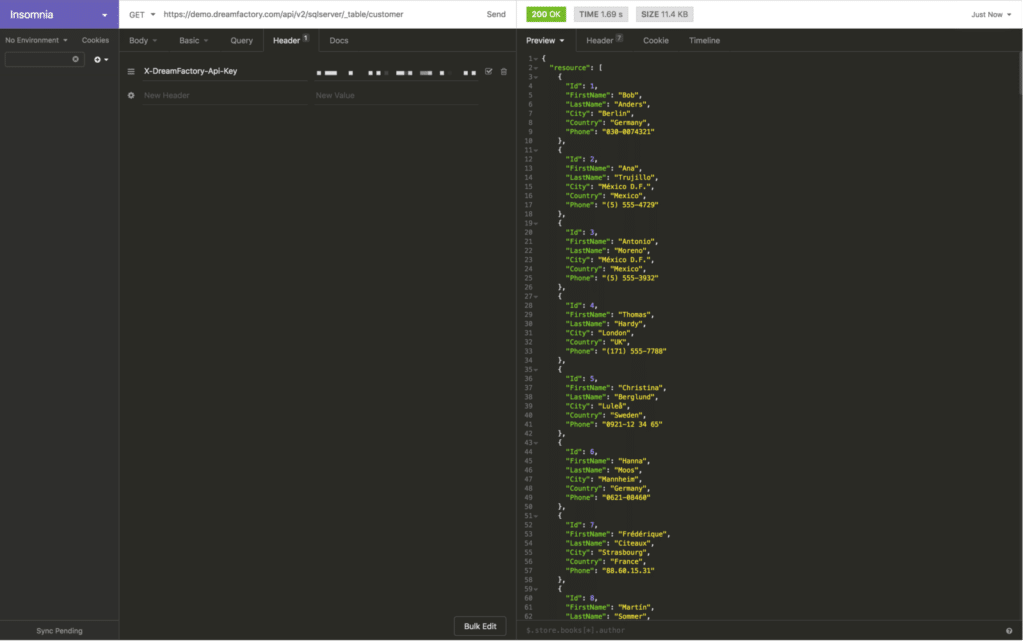
Look at that! A fully-documented, fully-secured, ready-to-use Microsoft SQL Server REST API in 11 minutes flat! Not only is DreamFactory fast, but it’s a joy to use. Does it get any better?
Final Thoughts on Hand-Coding APIs vs. DreamFactory
One of our primary missions at DreamFactory is to eliminate the costs and delays associated with traditional API development. Not convinced?
While some use-cases for hand-coding persist, in most scenarios, DreamFactory’s automatic API generation tools can dramatically speed up your time to market, lower your app development costs, and help you stay competitive in a market where rapid API development is essential.
We know you’re going to love saving time and money with DreamFactory’s automatic API generation capabilities – but you don’t have to take our word for it. Contact us with any questions. Our engineers are happy to give you a personalized tour.
Frequently Asked Questions: Hand Coding an API vs. API Generation
1. Why choose DreamFactory for API generation over hand-coding?
DreamFactory automates the generation of fully-documented, RESTful APIs, saving substantial development time and costs compared to hand-coding. Instead of spending weeks developing an API from scratch, DreamFactory enables you to create one in minutes by connecting your database.
2. What are the main advantages of using DreamFactory to generate APIs?
Using DreamFactory to generate APIs allows for rapid deployment, lower labor costs, and instant documentation with Swagger. DreamFactory also provides built-in security (like API keys and Role-Based Access Control) and monitoring features, reducing the need for additional configurations that typically add to the cost of hand-coded APIs.
3. How much does it typically cost to hand-code an API compared to using DreamFactory?
Hand-coding a custom SQL Server API can take around 25 days and cost approximately $20,000 for in-house development. DreamFactory, on the other hand, can generate a similar API in just over an hour for about $118.30, assuming the same labor rate.
4. What are the key steps involved in hand-coding an API?
Creating an API from scratch includes several phases: research, database schema design, API prototyping, implementing security, generating documentation, setting rate limits, and configuring logging/monitoring. Each step adds to the project timeline, with hand-coded APIs typically requiring several weeks to complete.
5. Can I still customize APIs generated with DreamFactory?
Yes, DreamFactory provides flexibility with built-in customization options. While automated, you can adjust settings, add custom scripting, and define role-based access controls, among other features, to align the generated API with your application needs.
6. Is DreamFactory’s auto-generated API as secure as a manually coded API?
Absolutely. DreamFactory includes essential security measures like API keys, RBAC, and rate limiting out of the box. You can configure additional security settings for your API, including OAuth, SAML, LDAP, and even endpoint-specific rate limiting to protect against overuse and abuse.
7. Does DreamFactory generate API documentation automatically?
Yes, DreamFactory generates full Swagger documentation automatically when creating an API. This means developers can interact with and test endpoints right away, streamlining both internal and client-facing development processes.
Fascinated by emerging technologies, Jeremy Hillpot uses his backgrounds in legal writing and technology to provide a unique perspective on a vast array of topics including enterprise technology, SQL, data science, SaaS applications, investment fraud, and the law.


























